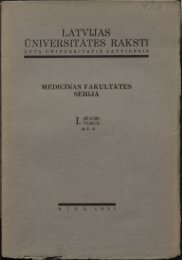UNIVERSITATIS LATVIENSIS - DSpace
UNIVERSITATIS LATVIENSIS - DSpace
UNIVERSITATIS LATVIENSIS - DSpace
Erfolgreiche ePaper selbst erstellen
Machen Sie aus Ihren PDF Publikationen ein blätterbares Flipbook mit unserer einzigartigen Google optimierten e-Paper Software.
On the development of pollen and embryo-<br />
represent<br />
sac of Papaver Rhoeas L.<br />
By Marija<br />
Vilcins and Karlis Abele.<br />
The young anthers in their early stages of development<br />
sperms. A young<br />
the usual appearance of anther development of angio-<br />
anther is an elevated little protuberance with<br />
cells not yet differentiated (Fig. 3, 5). Contemporarily with the<br />
continuation of development begins the differentiation of the<br />
sporogenous cells. The pollen mother cells are growing larger,<br />
forming more extensive nuclei and becoming more stained with<br />
haematoxylin and gentiana-violett-eosin. Already in the early<br />
stages of the anthers the development of vascular tissue can be<br />
noticed (Fig. 6).<br />
The sporogenous cells become gradually richer in plasma.<br />
At the beginning of the development of the pollen<br />
mother cells<br />
the tapetum cells cannot be observed, later they appear<br />
in the<br />
form of a layer of one row of cells, that differ from the sporo-<br />
genous cells (Fig. 7). As soon as the pollen-sack is covered<br />
by the tapetum cells, the pollen mother cells enter the prophase<br />
of tetrad division. The tapetum cells differ from the pollen<br />
mother cells in their peculiar appearance<br />
and their often remar-<br />
kable size (20p.<br />
—<br />
40p.). In<br />
many cases the tapetum<br />
cells are<br />
2-nucleate. The two nuclei arise from the usual mitotic division<br />
of nucleus, but no division of cell follows the division of nuc-<br />
leus, and the formation of the wall fails to appear.<br />
Both the<br />
nuclei of the 2-nucleate cells can be observed without a connec-<br />
tion between them, but in many<br />
cases between these nuclei can<br />
be seen some coherence, a kind of plasma bridge, or the nuclei<br />
may also be in connection between them forming a figure that<br />
looks like the amitotic division of a nucleus. There is reason<br />
to think that in these cases the nuclei flow together.<br />
There are<br />
also to be seen longish nuclei, that are evidently formed by the<br />
junction of the two nuclei. Nuclei, that arise in such a manner<br />
have two nucleoli, while the simple nuclei in other cells posses<br />
usually only<br />
one nucleolus.<br />
The 2-nucleate tapetum<br />
during the development of the pollen<br />
the final corrosion.<br />
cells remain in this condition also<br />
and can be observed till<br />
It can be added to the description of the tapetum cells,<br />
that in the part which is nearer to the epidermis of the anther,<br />
Acta Hortl Bot. Unlver». Latv. 11. 9


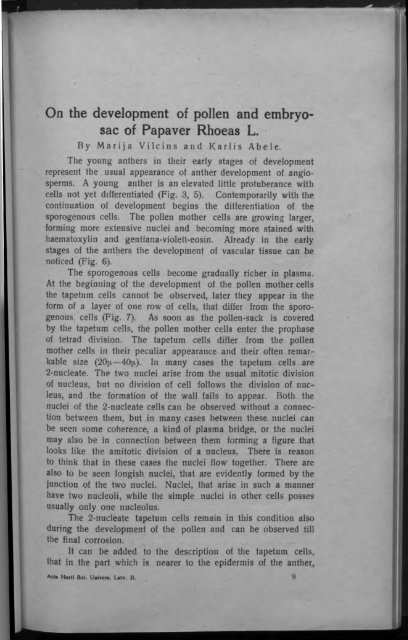
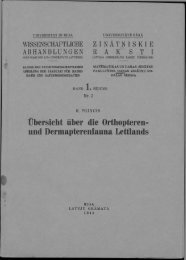
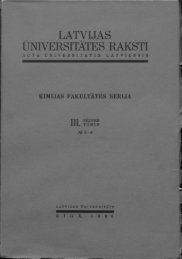
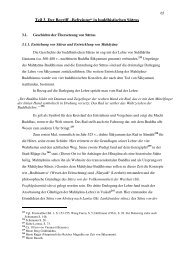
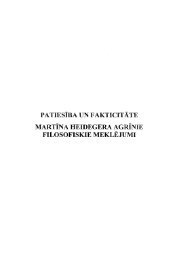
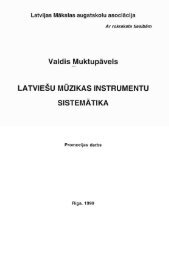
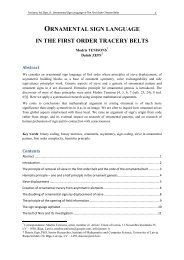
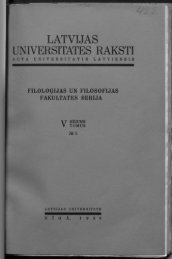
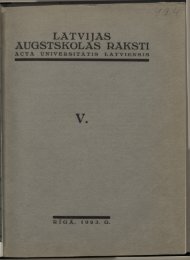


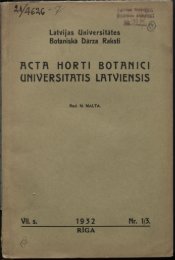
![LATVIJAS] - DSpace](https://img.yumpu.com/11778577/1/190x249/latvijas-dspace.jpg?quality=85)
